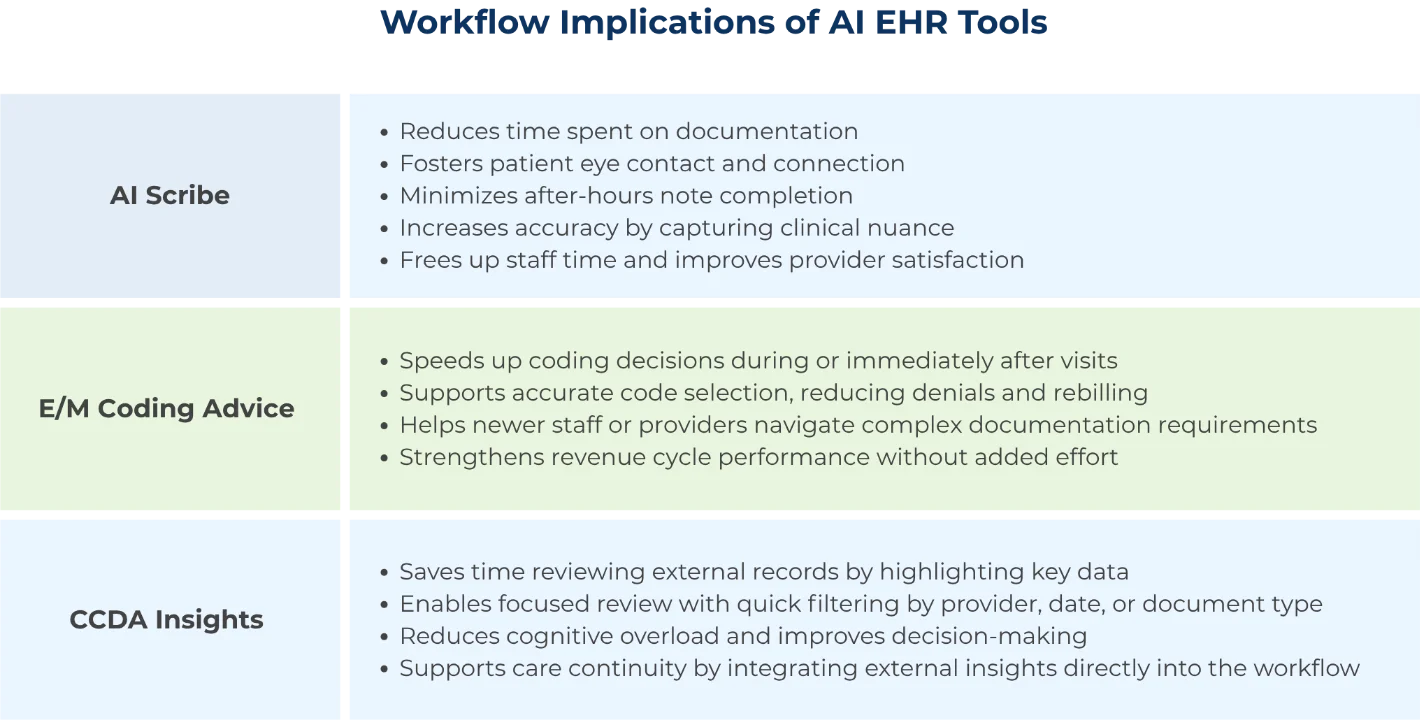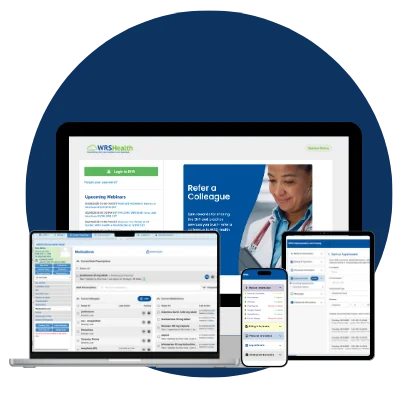Key Takeaways
- AI EHR tools reduce administrative burden by automating tasks like documentation, scheduling, and data entry.
- Smart EHR integrations support clinical decision-making through predictive insights and real-time alerts.
- Practices that adopt AI-powered systems can improve efficiency, patient outcomes, and staff satisfaction.
- Find out how one provider rediscovered the joy of practice ownership with WRS.
The shift to electronic health records (EHRs) was meant to help practices better manage patient documentation and simplify clinical operations. And in many ways, it has. Yet as any provider or practice manager knows, there’s a dark side to clunky EHRs. Systems that are overly complex or overengineered often demand too many clicks and place unexpected strain on your time and focus
Artificial intelligence (AI) is positioned to impact the way practices operate with features and functions that go far beyond the early days of electronic records. From automated administrative tasks to advanced clinical highlights, AI EHR tools shift how practices operate on a daily basis. These innovative systems drive meaningful change at the point of care, elevating patient outcomes and energizing provider performance.
Let’s explore how AI EHR solutions improve the way practices work and what capabilities tech systems bring to the table. Forward-thinking administrators, physicians, and practice leaders prepare for the next phase of healthcare innovation by equipping themselves with the right information from the start.
Table of Contents
- Key Takeaways
- The Evolution of EHR Systems
- The Promise of AI EHR Integration
- AI and Administrative Efficiency
- Smarter Clinical Documentation
- Enhanced Clinical Decision Support
- Interoperability That Actually Works
- Addressing Security and Compliance Concerns
- Where Practice Leaders Should Focus Next
- Looking Ahead: AI as a Healthcare Ally
- Setting the Stage for Intentional AI Integrations
- Related Posts
The Evolution of EHR Systems
Before exploring what AI can do for your practice, let’s look briefly at how EHR systems came to be. At their core, EHRs were designed to consolidate patient data into a digital format to replace fragmented, paper-based records. They also aimed to simplify tasks like quality reporting, billing, and regulatory compliance—no more rifling through filing cabinets or chasing down missing referrals.
But as more practices adopted EHRs, a new problem emerged: these systems weren’t designed with human workflow in mind. Providers began spending more time documenting than interacting with patients. Charting fatigue set in. Administrative teams found themselves toggling between systems just to get through a single appointment. Efficiency gains plateaued, and frustrations grew for both providers and patients.
Over time, technology has improved and physician-designed platforms have made EHRs more usable. But the rise of AI marks a turning point. Rather than a flashy add-on, integrated AI emerges as a critical enhancement—one that helps EHR systems finally serve the people who use them every day.
The Promise of AI EHR Integration
So, how will AI help change EHR platforms?
Simply put, AI introduces the power of smart automation, predictive analytics, and natural language processing (NLP) into the EHR workflow. That means:
- Less time typing and more time connecting
- Fewer repetitive tasks and more strategic focus
- Faster insights and more informed decisions
Think of it this way: building a house with a jumbled pile of materials takes time, patience, and a lot of guesswork. But when those items are neatly sorted by size, color, and function, the process becomes faster, smoother, and more precise. That’s the difference AI brings to EHR systems—it organizes, interprets, and streamlines the raw data clinicians deal with every day.
Now, let’s explore the real-world impact of using AI to improve electronic health records across key areas of practice operations.
AI and Administrative Efficiency
One of the most immediate benefits of AI in EHRs is the automation of routine front-desk and back-office tasks. Think appointment scheduling, insurance verification, and patient intake. These may seem like quick tasks, but when repeated hundreds of times per week, they absorb massive amounts of staff time.
AI tools can now handle patient check-ins through voice or text interfaces, scan and extract insurance details from images or PDFs, and even autofill registration forms directly into the EHR. This speeds up the entire onboarding process and reduces the chance of human error.
Voice-enabled phone agents are also becoming more common. Rather than letting calls pile up or sending patients into endless voicemail loops, AI phone systems can handle real-time appointment booking, medication refill requests, and answer common billing questions. These systems are always on the clock, which is especially valuable for practices with overtaxed admin teams.
The cumulative effect is significant: higher patient satisfaction, reduced burnout for front office staff, and lower overhead for the practice.

Smarter Clinical Documentation
Ask any provider what they dread most after a long day, and the answer is often the same—charting. Clinical documentation is a requirement for both continuity of care and billing compliance, and it can be time-consuming if your systems aren’t supporting you the right way.
This is where AI can truly shine.
With NLP, AI tools can transcribe doctor-patient conversations in real time, then convert that dialogue into structured clinical notes. The system recognizes medical terminology, organizes notes by section, and even suggests relevant ICD-10 codes. Providers still review and approve documentation, but the bulk of the typing is eliminated.
The difference this makes is hard to overstate. Clinicians can wrap up documentation shortly after each encounter rather than burning out in the evenings with hours of unfinished charts.
Worried about trusting the system? AI accuracy is improving fast. Systems now capture speech, and learn the user’s habits, preferences, and style over time. That means fewer corrections, less clicking, and a smoother clinical rhythm.
Want a deeper dive on how AI solves for EHR challenges? Read our guide
Enhanced Clinical Decision Support
Reclaiming provider time is a major win, but the real power of AI EHR tools lies in how they elevate clinical decision-making. AI EHR tools are changing the way practices work by introducing predictive insights that directly influence patient care.
AI algorithms trained on massive datasets can now alert providers when a patient shows early warning signs of conditions like diabetes, heart failure, or depression—even if those signs haven’t triggered any traditional flags yet.
These alerts aren’t only based on vital signs or labs. AI analyzes clinical notes, past encounters, imaging, and social determinants of health to uncover patterns that providers might miss amid the noise of information overload.
For instance, a patient presenting with mild fatigue and joint pain might not raise alarm bells initially. But AI may detect a pattern deep within the patient’s history that aligns with early autoimmune disease, prompting the provider to order specific tests. That kind of support improves care and can prevent costly downstream complications.
AI also helps with medication safety. New tools can analyze drug interactions, dose appropriateness, and even alert providers to patients at risk of non-compliance—information that often hides between the lines in traditional EHR fields.
Interoperability That Actually Works
Another persistent problem in healthcare has been the inability of different EHR systems to communicate. One hospital’s system doesn’t talk to another’s. Specialists can’t see updates from the primary care provider. Patients have to repeat their histories again and again.
AI is helping close gaps that degrade care quality by adapting to existing data formats and filling in the blanks intelligently.
For example, when a referring physician sends over incomplete records, AI can infer what’s missing based on context. If a medication name is abbreviated or misspelled, the system can recognize it and map it correctly. If lab results are formatted differently across systems, AI can harmonize them into a usable structure for the receiving provider.
With the help of industry standards like HL7 and FHIR, AI-enhanced systems can act as translators between platforms, smoothing data exchange and preventing key details from getting lost in handoffs.
The result: better care coordination, fewer repeated tests, and less time digging through PDFs and attachments.
Addressing Security and Compliance Concerns
Naturally, any discussion of AI and EHRs raises concerns about data privacy and HIPAA compliance. These concerns are valid—and solvable.
The best AI EHR tools are built with end-to-end encryption, strict access controls, and audit trails to track every action. In fact, ecosystem security is often improved with AI integration by reducing the need for human intervention. Fewer manual entries mean fewer opportunities for errors or breaches.
Blockchain technology is gaining ground as a method for improving EHR security and trust. It creates verifiable records that remain tamper-proof and accessible only with proper authorization. In high-risk areas like mental health or addiction treatment, this kind of transparency is especially valuable.
Ultimately, the key to upholding security and compliance is responsible design. AI in healthcare must be explainable, testable, and continuously monitored for bias or error. That’s why medical AI tools go through extensive validation before being deployed—and why human oversight will always be part of the picture.
Where Practice Leaders Should Focus Next
For practice owners, administrators, and managers, the rise of AI in EHRs is a strategic opportunity. Despite the benefits, considering a transition can be overwhelming and it doesn’t happen overnight.
Here are three areas where leadership can focus now:
- Vendor Evaluation: Not all AI EHR tools are created equal. Look for solutions that are purpose-built for medical practices (not adapted from other industries), and that support your specialty. Ask vendors how their tools handle real-world workflows—not just demo scenarios.
- Staff Training and Buy-In: Introducing AI requires cultural change. Get your team involved early. Explain how the tools will help—not replace—them. Provide training that focuses on hands-on use cases rather than generic tutorials.
- Infrastructure Readiness: Make sure your current EHR system is capable of integrating with AI tools. That means checking API availability, reviewing data-sharing agreements, and ensuring your internet connectivity and hardware can support cloud-based automation.
By taking these steps now, practices lay the groundwork to adopt AI effectively and roll out future features smoothly, without avoidable setbacks.
Looking Ahead: AI as a Healthcare Ally
As we look to the future, the question isn’t whether AI will change EHRs. It’s how deeply that change will shape daily practice operations—and whether practices are ready to harness its full potential.
Already, we’re seeing AI EHR tools reduce documentation time, cut claim denials through better coding, and improve diagnostic accuracy for complex cases. And this is just the beginning.
Soon, we’ll see AI-driven assistants integrated directly into patient portals. Voice-activated charting will become the norm, not the exception. Predictive analytics will proactively flag patients at risk before they even schedule an appointment.
For practices willing to embrace change, the rewards are substantial: better efficiency, stronger patient relationships, and a team that spends less time on paperwork. When administrative burdens go down, both work-life balance and quality of care go up. It’s a win for providers and for patients.
Setting the Stage for Intentional AI Integrations
Healthtech is advancing at a rapid pace, with artificial intelligence driving much of the transformation. While there is still work to be done to address transparency, equity, and data governance, the early results are overwhelmingly promising.
AI EHR tools are a powerful partner. They offer a new way forward—one where technology works in the background, quietly supporting clinical excellence without getting in the way.
For healthcare practices that have long struggled to balance care quality with administrative demands, this moment is as much a technical upgrade as it is a turning point.
And for those asking, “How will AI help change EHR systems?”—the answer is unfolding right now, in exam rooms, front offices, and practice dashboards across the country.






 QUICK CHARTING
QUICK CHARTING NOTE
NOTE MEDICATION
MEDICATION PATIENT
PATIENT BILLING
BILLING RISK
RISK MARKETING
MARKETING MIPS
MIPS